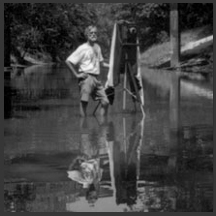 For me, making pictures is like seeing something magical in the mundane. I usually photograph places and things that are near and familiar — a studio portrait of a friend, a 'botanical' in the back-yard, a rural cityscape or landscape in mid-Alabama that I passed through as a child with my Dad, or maybe just a downtown view of some portion of an old building. What I'm particularly interested in is the Common Place and those wonderful instances where mystery seems to lie in wait, present or at least seems present when I am observing it closely. Like the mystery and magic of the cigar box that Scout opens in the beginning of "To Kill A Mockingbird". She opens that drab little box as she hums in that delightfully sweet way and reveals all those familiar and seemingly mundane trinkets and suddenly the contents and the box itself become extraordinary and very important.
For me, making pictures is like seeing something magical in the mundane. I usually photograph places and things that are near and familiar — a studio portrait of a friend, a 'botanical' in the back-yard, a rural cityscape or landscape in mid-Alabama that I passed through as a child with my Dad, or maybe just a downtown view of some portion of an old building. What I'm particularly interested in is the Common Place and those wonderful instances where mystery seems to lie in wait, present or at least seems present when I am observing it closely. Like the mystery and magic of the cigar box that Scout opens in the beginning of "To Kill A Mockingbird". She opens that drab little box as she hums in that delightfully sweet way and reveals all those familiar and seemingly mundane trinkets and suddenly the contents and the box itself become extraordinary and very important.
The 8x10 and 8x20 view cameras aid in that magic and mystery because the ground glass reveals details in the world very clearly, both near and far. Sometimes, it seems that the camera can capture textures and tones that go unnoticed in direct observations. We can't see all that the camera can see. We are distracted by color, shape, distance and a myriad of other things. But the camera sees it and solidifies it so that all those subtle nuances are exquisitely preserved on that fragile, oversized piece of film.
When I find something I want to photograph, I am forced to spend some time with it by the deliberateness and slowness of setting up the large camera. While setting up, I usually study my subject as I attend to the mechanics of the camera. Then the rush to view it on the groundglass under the darkcloth, turn a knob here, tilt the tripod there. What I see on the ground glass is what my picture will be in terms of boundaries, by what I include or exclude. And that magic image is abstract & upside down, but further study, maybe a few adjustments, a meter reading and I am ready to pull the darkslide. But that's only part of the magic. The rest of the magic occurs when the negative is processed and the contact print is made.
The negatives develop like topographic maps — very real, giving tones, texures, height and depth in a transparent emulsion. The image itself is made of layers of silver that one darkens with light. Watching the picture slowly reveal itself to me is like practicing some arcane ritual that creates a thing of beauty out of nearly nothing. The negative is beautiful in its subtle tones of blacks and browns and the bas-relief images that lie on it, in it. Taking that negative and transferring it onto paper is another step in the spell that will create a picture. It is an amalgam of science and artistry. All the chemistry is before me and I must rely on my knowledge of those mixtures and my experience in the darkroom to arrive at the contrast and tones that I want my picture to hold. All the while the timer is ticking, metering out my movements and advances through the process.
From beginning to end, the process of making pictures is both familiar and magical for me. All the steps in the incantation are very real to me, very familiar. The subject matter is familiar, the process is familiar, the rhythm is familiar. But like many things around us, things we often overlook, they hold their own special magic. Our world is full of magic, mystery and unnoticed beauty. The process of discovering that magic is beauty in itself. That's what I relish and that's why I make pictures.